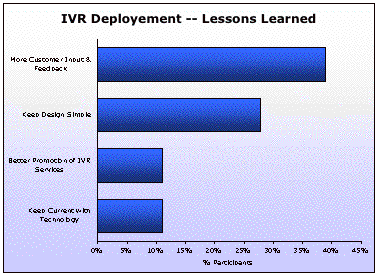|
|


IVR Interactive Voice Response
This section of our technical library presents information and documentation relating to IVR and interactive voice response software as well as automatic call answering solutions.
Business phone systems and toll free answering systems (generally 800 numbers and their equivalent) are very popular for service and sales organizations, allowing customers and prospects to call your organization anywhere in the country.
Our PACER and Wizard IVR systems add another dimension to our call center phone system solutions. An Interactive Voice Response (IVR) processes inbound phone calls, plays recorded messages including information extracted from databases and the internet, and potentially routes calls to either in-house service agents or transfers the caller to an outside extension.
The Customer Experience is It!
Extract from IVR Improvement Strategies,
A new research report published by the Ascent Group, Inc.
The technical
definition of Integrated Voice Response (IVR) is a telecommunications
system that accepts a combination of voice and telephone touch-tone
keypad input and provides appropriate responses in the form of voice,
fax, callback, e-mail and perhaps other media. Ask anyone on the
street and you'll most likely hear the following definition--"those
confounded machines that won't let you talk to humans."
With the
advent of IVR technology more than a decade ago, many predicted the
demise of the call center. The promise of automation proved so alluring
that many implemented IVR technology with little or no consideration
of the customer experience. In fact, many IVR applications provided
absolutely no way of opting out to an agent, all in the name of reducing
agent-handled calls. The all-out push for automation was devastating--most
customers hated IVR technology. IVR became a "bad name", making it
even more difficult for those companies just embarking on an implementation.
In many cases, companies implementing IVR systems were worse off
than if they hadn't done anything at all. Poorly designed IVR implementations
dissatisfied customers, lost sales, and ironically ended up increasing
calls into the center rather than eliminating them.
Benchmark
Study of IVR Deployment
To better
understand the state-of-IVR today, the Ascent Group recently conducted
a benchmarking project to evaluate IVR performance, to understand
the never-ending deployment challenges, and to identify IVR "best
practices". Companies from nine industries participated in the research.
The following pages summarize the study's objectives, findings and
observations, and recommendations.
The main
objective of the study was to evaluate the strategic deployment of
interactive voice response technology and to identify best practices
or opportunities for improvement. Secondary objectives included understanding:
- The
range of deployment strategies;
- Primary
business objectives and drivers of IVR deployment;
- How
IVR technology fits into a customer service strategy, and
- How
companies incorporate the customer perspective.
Participants
were asked to share the history of their IVR implementation, deployment
and design strategies, performance statistics, best practices, and
lessons learned. The study also asked companies to relate how they
measure the success of their IVR implementation and plans moving
forward.

What
Did We Learn?
-
The
most frequently cited "lessons learned" was the need to incorporate
customer input and feedback into the design and ongoing management
of an IVR system. Companies are not taking the time or effort
to gain knowledge from the customer experience--a critical mistake
that can inflict serious damage to your customer satisfaction
ratings, and ultimately bottom-line revenue.
-
More
than 40 percent of study participants utilize automated speech
recognition (ASR), which further confirms the progress of IVR
technology in the marketplace. Another 32 percent have plans
to implement speech recognition in the near future. In a similar
study conducted by the Ascent Group in 2000, speech recognition
was only prevalent in less than 10 percent of companies. At that
time, most were waiting for the technology to improve, and it
clearly has.
-
Companies
Implementing IVR Systems Report Significant Benefits. Nearly
all participants reported benefits of reduced or avoided costs.
Companies migrating from touch-tone to ASR generally reported
a 15 to 20 percent gain in call completions. Others reported
increased customer satisfaction for after-hours self-service
options. Estimating the number of agent-equivalents that would
have been required to handle IVR completed calls--our panel
ranged from 1 to 10,000 equivalent FTEs (two companies reported
very significant FTE equivalents). Excluding the largest, the
panel average 85 FTE equivalents--very real cost savings or
avoidance.
-
Companies
Are Not Adequately Capturing the Customer Experience. Only
half of participants actively measure IVR customer satisfaction
(or have measured at one time). Only 14 percent report the
adoption of usability labs or prototype testing. For those
that do gather customer feedback, it's usually obtained from
customer surveys or focus groups, and not necessarily on a
regular basis or coincidental to any changes.
In
addition, only a little more than one-third utilize call monitoring
(live or recorded calls) to observe the quality of the caller's
interaction with the IVR. What is more surprising is that two-thirds
of the participants with speech-enabled IVRs don't utilize IVR
call monitoring at all.
-
Companies
Are Not Promoting IVR Self-Services. Less than a third
of participants promote IVR Self-Services to customers
or callers. And, of those that do, this usually means printed
messages on bills or on bill stuffers. A small percentage
(27 percent) promotes through discounts or no-charge services,
and even fewer (14 percent) asked agents to promote usage,
when appropriate.
-
Few
Companies Test IVR Operational Performance. Only
18 percent of participants use or have used a service
or application to monitor and test IVR system reliability
and operational performance. These applications conduct
stress tests and other simulation tests to measure IVR,
system, and network responsiveness and reliability.
-
Companies
that "Selectively Force Callers through the IVR" achieve
the Highest IVR Success Rates. 40 percent of participants
selectively force callers through the IVR for some
services. These same companies averaged the highest
IVR Success Rates--more
than 40 percent (percent of IVR completed calls versus
total handled calls). Conversely, companies that present
IVR services as "optional" average an IVR Success Rate
of only 13 percent.
-
Speech-enabled
IVR Applications Experienced Higher Growth in IVR Success
Rate than Touch-Tone Applications. Our evaluation of IVR
handled calls over the past three years indicates that companies
with ASR experienced a bigger growth in IVR handled calls than
those without ASR--68% growth versus 30% growth.
Wizard Simplifies Development
DSC provides IVR software including our IVR wizard development tool for creating interactive voice response applications.
Our IVR software lets you increase IVR development productivity by providing a visual development environment. IVR applications can be defined in minutes using this sophisticated, yet easy to use development tool.
DSC also has available a comprehensive IVR software library known as our IVR Wizard Software Development Kit. This optional package is available for programmers and systems adminstrators who wish to manage IVR programs fromLinux IVR, Unix, or Windows IVR operating environments.
Data collected by your phone ACD (Automatic Call Distribution) or IVR (Interactive Voice Response) systems can be passed to your existing PC, Unix or Web applications through our phone software.
The PACER predictive dialer can automatically call your customers and pass only connected calls to your agents. With our computer telephony software, your telephone and computer work together to provide cost-saving benefits.
|





